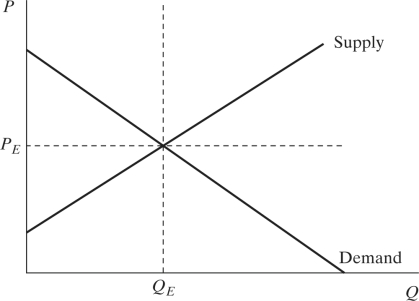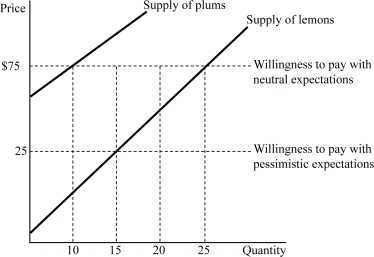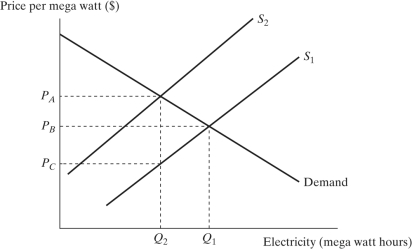A) 1
B) 2
C) 3
D) 4
F) C) and D)
Correct Answer

verified
Correct Answer
verified
Multiple Choice
 Figure 9.6
-A firm that generates pollution is illustrated in Figure 9.6. Suppose the government is considering changing the pollution tax from P3 to P2. That new policy would
Figure 9.6
-A firm that generates pollution is illustrated in Figure 9.6. Suppose the government is considering changing the pollution tax from P3 to P2. That new policy would
A) increase the marginal benefit to firms of abating, and thus encourage greater abatement.
B) increase the marginal benefit to firms of abating, causing them to generate more pollution.
C) reduce the marginal benefit to firms of abating, causing them to generate more pollution.
D) reduce the marginal benefit to firms of abating, and thus encourage greater abatement.
F) C) and D)
Correct Answer

verified
Correct Answer
verified
Multiple Choice
As long as two firms have different abatement costs, they:
A) can benefit under a system of marketable pollution permits by trading the right to pollute.
B) will prefer a pollution tax to a system of marketable pollution permits.
C) will decrease the price of their product if taxed on the amount of pollution they emit.
D) will not be able to benefit from trading the right to pollute under a system of marketable pollution permits.
F) None of the above
Correct Answer

verified
Correct Answer
verified
Multiple Choice
 Figure 9.7
-Consider Figure 9.7, which depicts the supply and demand for coal. Assume coal production creates external costs. If PE and QE are the equilibrium price and quantity of coal without government regulation, a pollution tax on the production of coal would _______ the price of coal relative to PE and _______ the quantity of coal relative to QE.
Figure 9.7
-Consider Figure 9.7, which depicts the supply and demand for coal. Assume coal production creates external costs. If PE and QE are the equilibrium price and quantity of coal without government regulation, a pollution tax on the production of coal would _______ the price of coal relative to PE and _______ the quantity of coal relative to QE.
A) increase; decrease
B) increase; not change
C) decrease; not change
D) decrease; decrease
F) A) and D)
Correct Answer

verified
A
Correct Answer
verified
Multiple Choice
Technological advances in pollution reduction
A) reduce the demand for pollution permits.
B) increase the demand for pollution permits.
C) reduce the supply of pollution permits.
D) increase the supply of pollution permits.
F) A) and C)
Correct Answer

verified
Correct Answer
verified
Multiple Choice
 Figure 9.3
-Figure 9.3 represents the market for used refrigerators. Suppose buyers are willing to pay $300 for a plum high-quality) used refrigerator and $100 for a lemon low-quality) used refrigerator. Initially buyers believe that 50% of used refrigerators in the market are lemons low quality) . Compared to the outcome with neutral expectations, how many fewer refrigerators are sold in equilibrium?
Figure 9.3
-Figure 9.3 represents the market for used refrigerators. Suppose buyers are willing to pay $300 for a plum high-quality) used refrigerator and $100 for a lemon low-quality) used refrigerator. Initially buyers believe that 50% of used refrigerators in the market are lemons low quality) . Compared to the outcome with neutral expectations, how many fewer refrigerators are sold in equilibrium?
A) 50
B) 125
C) 175
D) 250
F) B) and D)
Correct Answer

verified
Correct Answer
verified
Multiple Choice
Suppose that there are two firms, each generating three tons of SO 2 . Suppose also that the government has set a target abatement level of two tons. Under a policy of uniform abatement with permits the firm with the lower marginal abatement cost
A) will abate exactly the same amount of SO2 as the firm with the higher marginal abatement cost.
B) will abate less SO2 than the firm with the higher marginal abatement cost.
C) will abate more SO2 than the firm with the higher marginal abatement cost.
D) will sell its pollution permit to the firm with the higher marginal abatement cost.
F) A) and B)
Correct Answer

verified
Correct Answer
verified
Multiple Choice
 Figure 9.6
-A firm that generates pollution is illustrated in Figure 9.6. The government has chosen to impose a pollution tax equal to P2. From the firmʹs point of view, the marginal benefit of abatement is
Figure 9.6
-A firm that generates pollution is illustrated in Figure 9.6. The government has chosen to impose a pollution tax equal to P2. From the firmʹs point of view, the marginal benefit of abatement is
A) avoiding the pollution tax imposed by the government.
B) the positive publicity the firm will receive by having a ʺgreenʺ production plant.
C) the reciprocal of the marginal cost of abatement.
D) zero because abatement benefits the general public, not the firm.
F) B) and D)
Correct Answer

verified
Correct Answer
verified
Multiple Choice
CARFAX is a company that compiles and sells histories of used cars. CARFAX reduces the:
A) number of cars exchanged in the used car market.
B) information asymmetry in the used car market.
C) number of used cars offered for sale in the market.
D) cost of used cars in the market.
F) None of the above
Correct Answer

verified
Correct Answer
verified
Multiple Choice
In markets with imperfect information
A) buyers and sellers will use resources to acquire information before making decisions.
B) buyers will use resources to acquire information before making a decision, but sellers do not need to acquire additional information before making a decision.
C) sellers will use resources to acquire information before making a decision, but buyers do not need to acquire additional information before making a decision.
D) neither buyers nor sellers will be able to acquire information in order to make decisions.
F) All of the above
Correct Answer

verified
Correct Answer
verified
Multiple Choice
Under a system of marketable pollution permits the government:
A) chooses a level of pollution.
B) distributes permits to polluting firms.
C) allows firms to trade permits.
D) all of the above
F) A) and D)
Correct Answer

verified
Correct Answer
verified
Multiple Choice
If a pollution tax imposed on a firm is greater than than its external cost,
A) the externality will be fully internalized.
B) the social production cost will increase by the amount of the pollution tax.
C) the pollution tax will be efficient.
D) the firm will be producing too little from a societyʹs point of view.
F) A) and C)
Correct Answer

verified
Correct Answer
verified
True/False
It is efficient to reduce pollution up until the marginal benefit from reducing the pollution equals the marginal cost of abatement.
B) False
Correct Answer

verified
Correct Answer
verified
Essay
What are some of the ways a private group can overcome a free rider problem?
Correct Answer

verified
Giving a private gift with a contribution, arranging matching contributions and appealing to civic or moral responsibility by such methods as publicizing contributors.
Correct Answer
verified
Multiple Choice
 Figure 9.2
-Figure 9.2 represents the market for used cameras. Suppose buyers are willing to pay $125 for a plum high-quality) used camera and $25 for a lemon low-quality) used camera. If buyers believe that 50% of used cameras in the market are lemons low quality) , how many lemons low quality) will be supplied by sellers?
Figure 9.2
-Figure 9.2 represents the market for used cameras. Suppose buyers are willing to pay $125 for a plum high-quality) used camera and $25 for a lemon low-quality) used camera. If buyers believe that 50% of used cameras in the market are lemons low quality) , how many lemons low quality) will be supplied by sellers?
A) 10
B) 15
C) 20
D) 25
F) B) and C)
Correct Answer

verified
D
Correct Answer
verified
Multiple Choice
 Figure 9.8
-Figure 9.8 depicts a market for electricity. Assume electricity production incurs external costs. If the government imposes a pollution tax $T per mega kilowatt,
Figure 9.8
-Figure 9.8 depicts a market for electricity. Assume electricity production incurs external costs. If the government imposes a pollution tax $T per mega kilowatt,
A) the supply curve will shift to the right.
B) the supply curve will shift to the left.
C) demand curve will shift to the right.
D) demand curve will shift to the left.
F) B) and C)
Correct Answer

verified
Correct Answer
verified
Multiple Choice
Table 9.7 -Table 9.7 shows the production cost for two utilities at different levels of sulfur dioxide emissions. Assume that the government issued 8 marketable pollution permits to each firm. Suppose that Firm A has already sold a permit to Firm B. If Firm A contemplates selling a second permit to Firm B, what is Firm A?s willingness to accept?
A) $5,000
B) $6,000
C) $7,000
D) $8,000
F) A) and C)
Correct Answer

verified
Correct Answer
verified
Multiple Choice
An example of a good that is non-rival in consumption is:
A) a music CD.
B) a radio broadcast of a song.
C) a ticket to a concert.
D) a guitar.
F) A) and D)
Correct Answer

verified
Correct Answer
verified
True/False
Protecting endangered species is NOT an example of a public good because there are no external benefits associated with it.
B) False
Correct Answer

verified
Correct Answer
verified
Multiple Choice
Shows on broadcast TV, like ABC or NBC, are _______ and shows on cable TV, like MTV or HBO, are _______.
A) nonexcludable, excludable
B) excludable, nonexcludable
C) rival, nonrival
D) nonrival, nonexcludable
F) B) and C)
Correct Answer

verified
Correct Answer
verified
Showing 1 - 20 of 399
Related Exams